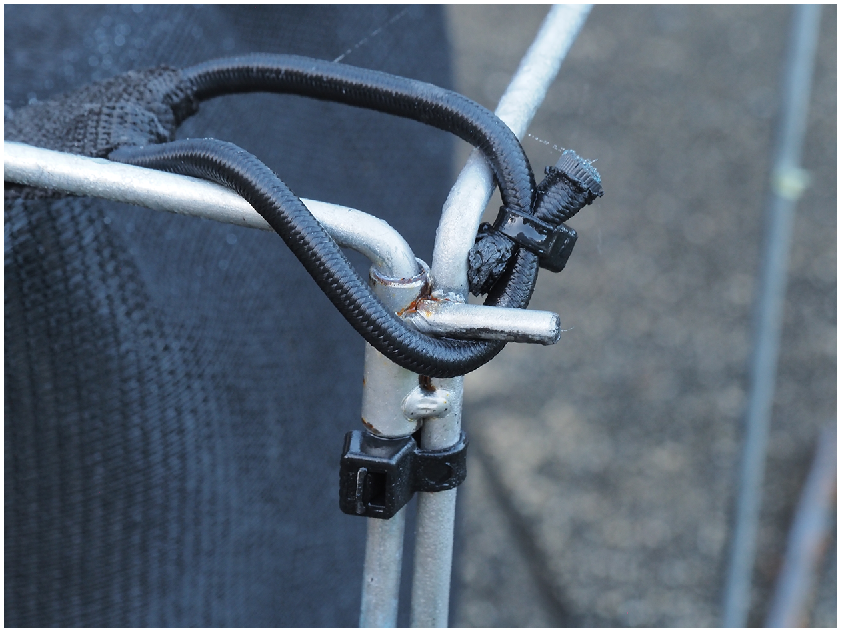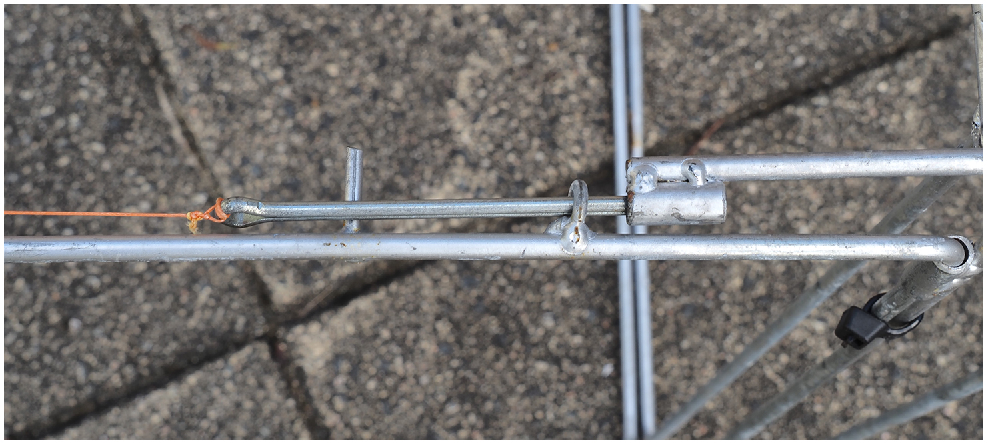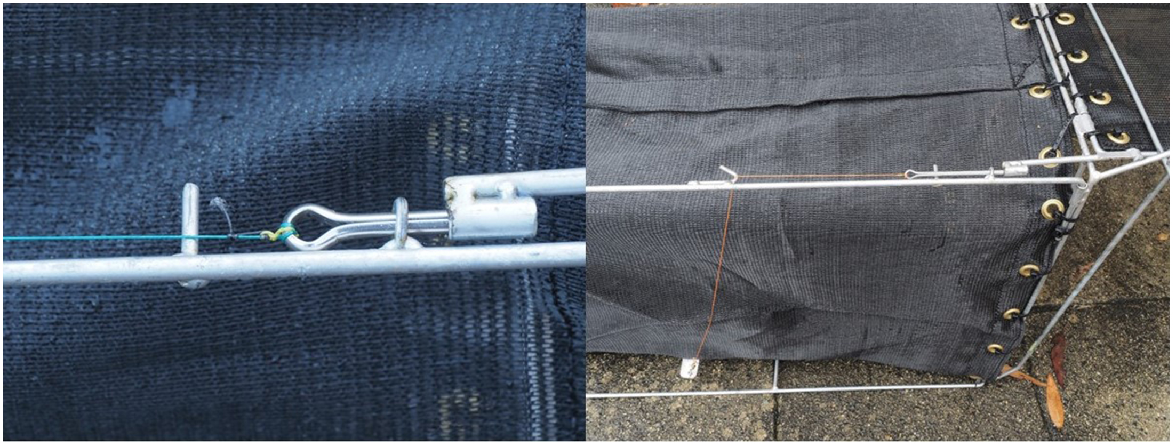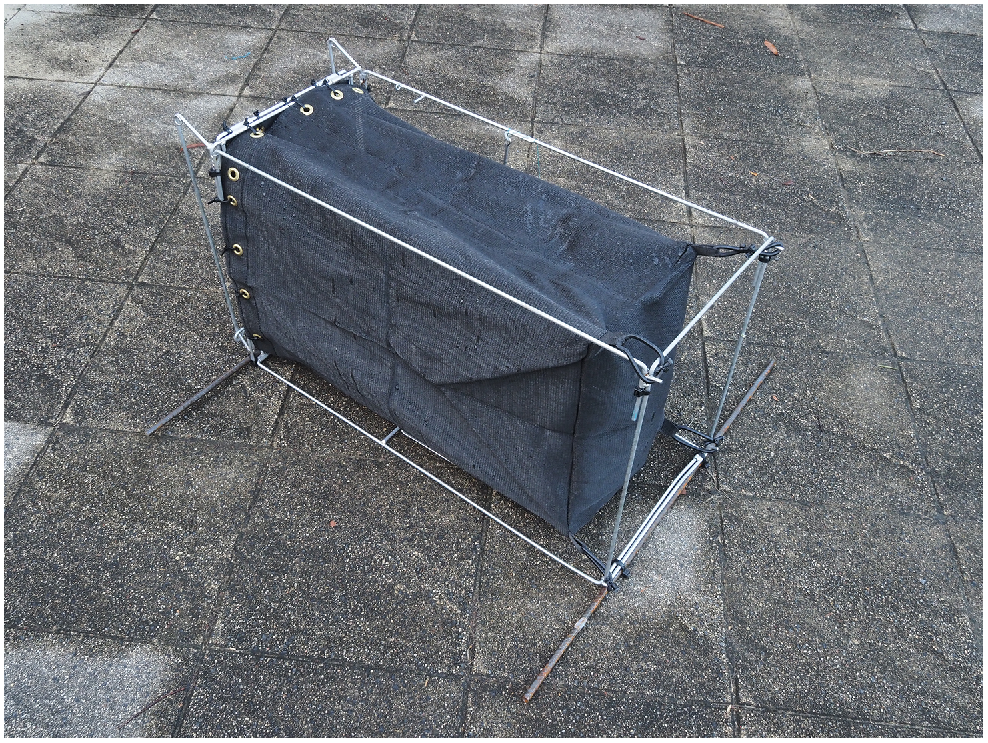Modifications to the soft-walled Thomas trap
P. D. Meek A B * , L. Collingridge C , D. Smith B C and N. Thomas D
A B * , L. Collingridge C , D. Smith B C and N. Thomas D
A
B
C
D
Abstract
We provide some recommended methods of modifying and using the Thomas trap to assist future use by field practitioners and to facilitate manufacture improvements. These recommendations are based on the original designer’s and author’s experience, and discussions with other practitioners.
Keywords: animal ethics, Brush-tailed rock wallaby, soft-sided trap, soft-walled trap, trap design modification, trapping macropod.
Introduction
Australia has been progressive in improving animal welfare outcomes in science and research over the past decades (NHMRC 2013; Smith et al. 2022). The adoption of the replacement, reduction and refinement principles (Zemanova 2020, 2021), together with ethical and responsible Australian scientists have helped produce humane alternatives in wildlife research. Trapping Australian wildlife and pests while trying to mitigate and minimise injuries and stress has a long history (Kinnear et al. 1988; Pollock and Montague 1991; Meek et al. 1995; Fleming et al. 1998; Meek et al. 2022; Smith et al. 2022). Wire cage traps have been used in Australia to trap native wildlife from rodent to macropod-sized animals for decades. Capture-related injuries vary with the structure of the cage and the size and behaviour of the animal in relation to the trap design. Some species are more predisposed to capture injuries than others, leading some researchers to develop soft-walled traps (Kinnear et al. 1988, 2014; Pollock and Montague 1991; Di Stefano et al. 2005). However, even the first iteration of the Bromilow trap (Kinnear et al. 1988), while innovative, was bulky to transport, difficult to set, prone to being inadvertently set off, and was difficult to extract animals.
The Thomas trap is a steel framed, soft-walled trap designed to catch animals such as Brush-tailed rock wallabies (Petrogale penicillata), which are prone to trap-related injuries. hese lightweight traps are collapsible to enable transport into difficult country. Thomas traps have been used for a range of species including Tammar wallaby (Macropus eugenii) (Chambers and Bencini 2010), Black-flanked rock wallabies (Petrogale lateralis lateralis) (Kinnear et al. 2010; Willers et al. 2011; Willers et al. 2015; Pearson et al. 2019), Yellow-footed rock wallabies (Petrogale xanthopus) (D. Taggart, pers. comm. 2024), and Short-eared possums (Trichosurus caninus) (McRae et al. 2023).
Thomas traps were originally designed for Mala (Lagorchestes hirsutus) by Neil Thomas in 2003 (360 mm × 330 mm × 820 mm). A modified trap was subsequently developed for larger species such as rock wallabies and Tammar wallabies; however, the larger trap had inherent stability and trigger issues not associated with the original trap intended for Mala. The traps are suitable for any medium-sized Australian mammal where the animals are known to be prone to capture stress and injuries in hard-walled traps. The trap size commonly used for larger wallabies such as rock wallabies are 480 mm high, 360 mm wide, and 820 mm long. They have a treadle trigger and soft-sided walls formed by a shade cloth sewn bag with a top entry zip (Fig. 1). These traps are provided by the manufacturer as separate sections and are designed to be stored and transported in a folded form. The galvanised steel rod frame (6 mm) is light weight to make it easier to carry the traps into difficult to access sites. The shade cloth (70%) woven internal bag, hereafter referred to as a Thomas bag, ensures that animals are contained after capture but are less likely to injure themselves during capture. Animals can be accessed and removed from the trap through a zipper system at the top of the bag, although some practitioners report difficulties using the zip access.
A UV stable cable tie locking the stabilising bar to the frame and the shock cord loop to attach the Thomas bag to the frame.

Since its development in 2003, Thomas traps have replaced most soft-walled traps. However, a change in the manufacturer ownership and other factors have not allowed the trap design and method to be revisited. Assembling these traps is time consuming compared to using cage traps and can be problematic for some practitioners. Clear instructions on how to best assemble the traps have not been produced and some of the original design features have been lost over time. The current manufacturers (Bollinger Sheffield Automation) are now working towards rectifying this in consultation with the authors. We report on several modifications to the traps to assist future practitioners, to ensure captured wildlife are safe and secure, and to optimise our capture efficacy. We trust these contribute to future manufacture and help produce a product that is easier to use by practitioners, while upholding the design features aimed at providing safer capture of wildlife.
Materials and results
The following recommendations were developed specifically for the 480 mm × 360 mm × 800 mm Thomas trap.
Side rails
The longitudinal side rails that run lengthwise along the top of the trap have a 90 degree bend that is inserted into a side rail sleeve vertically on the front and back of the trap. These bars slide into the tubing but are not snug and are easily dislodged when carrying the traps or when animals attempt to escape from capture. Some practitioners have increased the angle slightly to create force on the bracket, while others have wedged material in the tube to tighten the fitting. We recommend using 7.6 mm ultraviolet (UV) stable cable ties with a Stahl cable tie tensioning and cutting tool to fasten the bottom of the bar to the trap (Fig. 1). This resolves the problem; however future designs could include a small hole drilled into the bar below where it slides into the vertical sleeve and fixed using an R clip so that the bar is locked in place.
Thomas bag
The soft-walled bag restrains the animal once the treadle is depressed and is fixed to the front of the trap using the eyelet system and at the rear by four loops in each corner of the bag. The bag is fixed to the main frame by installing either plastic cable ties or tie wire through the eyelets. We initially chose wide cable ties (7.6 mm) so that they could not be broken by trapped animals but these proved problematic in how they were affixed to the trap door and front of the frame. The large locking mechanism of the 7.6-mm cable ties, if placed the wrong way, impede the front door locking bar, which allowed the animals to push the door back open and evade capture. Some practitioners complained that cable ties perished and broke due to the effects of sunlight on the plastic. Eyelets could be attached to the frame by being stitched on, but we have experienced chewing behaviour by Brush-tailed rock wallabies and bush rats and decided against a soft material. The most useful method in our experience is to use UV stabilised cable ties (4.8 mm) with a Stahl cable tie tensioning and cutting tool.
The rear bag tags can be attached with any method including cable ties, but the movement of the animal when caught can cause the tags to dislodge. To facilitate better tension on the bag when set, and ease of re-attachment after capture, we use black elastic bungee shock cord (6 mm wide and 230 mm long) that we loop through the tags and cable tie together (Fig. 1). The tension can be adjusted to suit the required pressure and wear and tear on the bag and tags. It is important not to make these loops too tight as this will create tension between the bottom of the Thomas bag and the treadle, which in turn causes the treadle trigger mechanism to tighten meaning the dog (see below) is under force.
Treadle attachment
When the trap is delivered, the company provide a split (cotter) pin to attach with a cable to the treadle, hereafter referred to as ‘the dog’. The original design used Venetian blind cord tied to the cotter pin and treadle (N. Thomas, pers. comm.). Some of these authors (PM, DS, LC) have tested the traps with string and found the stretch in the cord caused a delay in the depression of the treadle and the closure speed. We subsequently tested a piece of tie-wire that worked but was inflexible and difficult to use. We successfully tested a M5 (5 mm) diameter stainless steel split pin with 10 mm cut from the end, making it 55 mm in length, and also a M4 (4 mm) 95 mm split pin. The latter allows the longer dog to sit on the guide bar and into the eyelet (Fig. 2) and is our preferred option.
We attach a length of fishing J-Braid x 8 trace line (70–80 cm) tied to the dog eyelet (67 cm long) and then to the treadle plate using a Size 1 barrel interlock fishing swivel. The trace has 100 lb breaking strain, no stretch and is abrasion resistant (Fig. 3). When closing traps or transporting, the string can be wrapped around the side rails keeping it safe and out of the way unlike other more rigid treadle attachments, such as tie wire.
Stability bars
Thomas traps are by design very light weight, but the 480-mm tall version are readily turned over by animals during their attempts to escape the trap. Conventional methods of stabilising traps using tent pegs or alike to fix traps to the grounds are not possible in many rocky outcrop sites where these traps are used for Brush-tailed rock wallabies. We have used large rocks beside the traps to prevent traps rolling over, but these have often failed and contradict the purpose of having a soft-sided trap, as the rock merely creates a solid wall where animals could potentially harm themselves. In many situations, traps can be placed is naturally tight locations where the traps can not roll over. Where the natural terrain does not exist, we use a piece of steel rod (12 mm × 1 m) attached to the front and rear of the trap to prevent the trap rolling under the force of the animal pushing on the sides of the trap (Fig. 4). Future trap designs could include a sleeve on either side of the rear of the trap so that a longitudinal stabilising bar could be inserted and adjusted to suit the trap site topography.
Discussion
The modifications recommended have been tried and tested in the field by the authors. The stabilising bars provide a stable base and prevent traps from being rolled over by trapped wallabies. Prior to fitting the stabilising bars, Brush-tailed rock wallabies were able to escape by rolling over the traps and pushing the door open, even when tied down. There is one downside to the bars in that they need to be removed when collapsing and transporting the traps. Both split pin (dog) options worked with the braided fishing line and the swivel attachment to the treadle, although the long-split pin was preferred as it sits straight on the guide when set. Some practitioners advised that they have experienced issues with the trigger arm snapping, although these authors have not had that problem. The bungee shock cord was effective and is left on the Thomas bag after they are attached, they sometimes unhook from the trap when an animal is captured but are easily re-attached. As noted above, make sure there is no excessive tension on the treadle, Thomas bag and the dog so that the treadle will depress easily when the animal steps on it. One issue remains unresolved: the chewing of Thomas bags by Brush-tailed rock wallabies. On several occasions, we have had bags damaged by captured wallabies chewing through the shade cloth, so we advise that spare bags are kept in trapping kits during trapping exercises.
The Thomas trap provides an alternative solution to wire cage traps for trapping wildlife and improvements on soft-walled devices such as the Bromilow trap (Kinnear et al. 1988; Kinnear et al. 2014) and other soft-walled traps (Pollock and Montague 1991; Di Stefano et al. 2005), particularly where a species is prone to injury because of the behavioural response to capture and handling. Brush-tailed rock wallabies are prone to trap-related injuries when using cage traps because they are able to generate extreme force from a standing point in the trap. Wire cage traps have been modified for trapping rock wallabies by including corflute for cushioning (these authors) with some success. However, the Thomas trap provides a further level of safety for the trapped animals and the bag opening facilitates easier removal of animals from the trap when handling. To date, there has been little information provided in the literature on their use and modifications to improve design issues. We trust that the information outlined here provides an overview of the original design and suggested modifications to the traps as they are currently manufactured, therefore providing methods to ameliorate future issues with Thomas trap deployments. Moreover, we hope that the modifications provide the manufacturer with positive feedback for future design of these humane wildlife traps.
Conflicts of interest
The authors have no commercial interest in the manufacture of the Thomas traps and provide these suggestions to build on the original design.
Declaration of funding
While funding was not directly provided for the modification of traps, the method was facilitated during the capture and radio collaring of Brush-tailed rock wallabies, funded under the Regional Bushfire Recovery for Multiregional Species and Strategic Projects Program by the NSW Department of Industry, Science and Resources.
Acknowledgements
We thank David Taggart, Trent Forge, Annette Rypalski, and Michaela Jones for conversations about their experience using the traps.
References
Chambers B, Bencini R (2010) Road mortality reduces survival and population growth rates of tammar wallabies on Garden Island, Western Australia. Wildlife Research 37, 588-596.
| Crossref | Google Scholar |
Di Stefano J, Moyle R, Coulson G (2005) A soft-walled double-layered trap for capture of swamp wallabies (Wallabia bicolor). Australian Mammalogy 27, 235-238.
| Crossref | Google Scholar |
Fleming PJS, Allen LR, Berghout MJ, Meek PD, Pavlov PM, Stevens P, Strong K, Thompson JA, Thomson PC (1998) The performance of wild-canid traps in Australia: efficiency, selectivity and trap-related injuries. Wildlife Research 25, 327-338.
| Crossref | Google Scholar |
Kinnear JK, Bromilow RN, Onus ML, Sokolowski RES (1988) The Bromilow trap - a new risk-free soft trap suitable for small to medium-sized macropodids. Wildlife Research 15, 235-237.
| Crossref | Google Scholar |
Kinnear JE, Krebs CJ, Pentland C, Orell P, Holme C, Karvinen R (2010) Predator-baiting experiments for the conservation of rock-wallabies in Western Australia: A 25-year review with recent advances. Wildlife Research 37, 57-67.
| Crossref | Google Scholar |
Kinnear JE, Bromilow RN, Moore N (2014) The mark II Bromilow Kinnear humane soft trap: a major upgrade. Australian Mammalogy 36, 121-127.
| Crossref | Google Scholar |
McRae LJ, Griffin AS, Tuckey K, Hayward MW (2023) The population density and trap-revealed home range of short-eared possums (Trichosurus caninus) in the Northern Tablelands, New South Wales, Australia. Australian Mammalogy 45, 71-76.
| Crossref | Google Scholar |
Meek PD, Jenkins DJ, Morris B, Ardler AJ, Hawksby RJ (1995) Use of two humane leg-hold traps for catching pest species. Wildlife Research 22, 733-739.
| Crossref | Google Scholar |
Meek PD, Ballard GA, Mifsud G, Fleming PJS (2022) Foothold trapping for predators: Australia’s history, present and a future pathway for humane use. In ‘Mammal trapping: wildlife management, animal welfare and international standards’. (Ed. G Proulx) pp. 81–95. (Alpha Wildlife Publications: Alberta, Canada)
Pearson DJ, Neaves LE, Paxman M, Desmond A, Renwick J, Halley M, Willers N, Eldridge MDB (2019) Identification of a remnant population of the black-flanked rock-wallaby (Petrogale lateralis lateralis) in Kalbarri National Park, Western Australia, and implications for its management. Australian Mammalogy 41, 196-204.
| Crossref | Google Scholar |
Pollock DC, Montague TL (1991) Technical note: A new trap trigger mechanism for the capture of swamp wallabies, Wallabia bicolor (Marsupialia: Macropodidae). Wildlife Research 18, 459-461.
| Crossref | Google Scholar |
Willers N, Mawson P, Morris K, Bencini R (2011) Biology and population dynamics of the black-flanked rock-wallaby (Petrogale lateralis lateralis) in the central wheatbelt of Western Australia. Australian Mammalogy 33, 117-127.
| Crossref | Google Scholar |
Willers N, Martin GB, Matson P, Mawson PR, Morris K, Bencini R (2015) Finding the balance: fertility control for the management of fragmented populations of a threatened rock-wallaby species. Animals 5, 1329-1344.
| Crossref | Google Scholar | PubMed |
Zemanova MA (2020) Towards more compassionate wildlife research through the 3Rs principles: moving from invasive to non-invasive methods. Wildlife Biology 2020, wlb.00607.
| Crossref | Google Scholar |
Zemanova MA (2021) Making room for the 3Rs principles of animal use in ecology: potential issues identified through a survey. European Journal of Ecology 7, 18-39.
| Crossref | Google Scholar |





